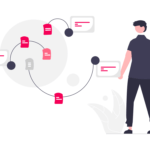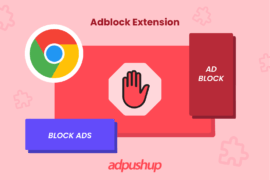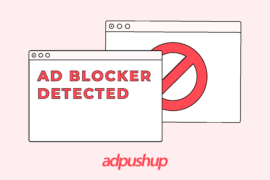In this blog post, we will delve into the world of ad blockers, explaining how they operate and offering strategies to monetize Ad block traffic while safeguarding your returns from diminishing.
To truly understand how to overcome ad blockers, it is essential to grasp their workings. Ad blockers are extensions for your web browser that halt communication between ad servers and your browser itself. By doing so, they cloak the specific elements of a website that are intended to display advertisements.
Consequently, when ad blocker users access such sites, these designated areas appear devoid of content, resembling empty spaces to the unsuspecting eyes of the end users.
Ad blockers work by disabling ad placements.
When a user installs an ad block plugin in their browser, it swiftly scans each web page they visit.
It looks for elements, such as scripts, links, folders, and CSS, that might be connected to the addresses in the filter list. If there’s a match, those elements are prevented from being shown.
Also Read: How to Detect Ad Blockers – Everything You Need to Know
1. Remove the Reason to Use Ad Block
Your audience uses adblock not out of spite but out of necessity. They don’t want to see you out of business; they just want to have a better user-experience.
30% of people use ad block because of security concerns. Another 29% use it because of interruptive ads, according to a survey by PageFair:
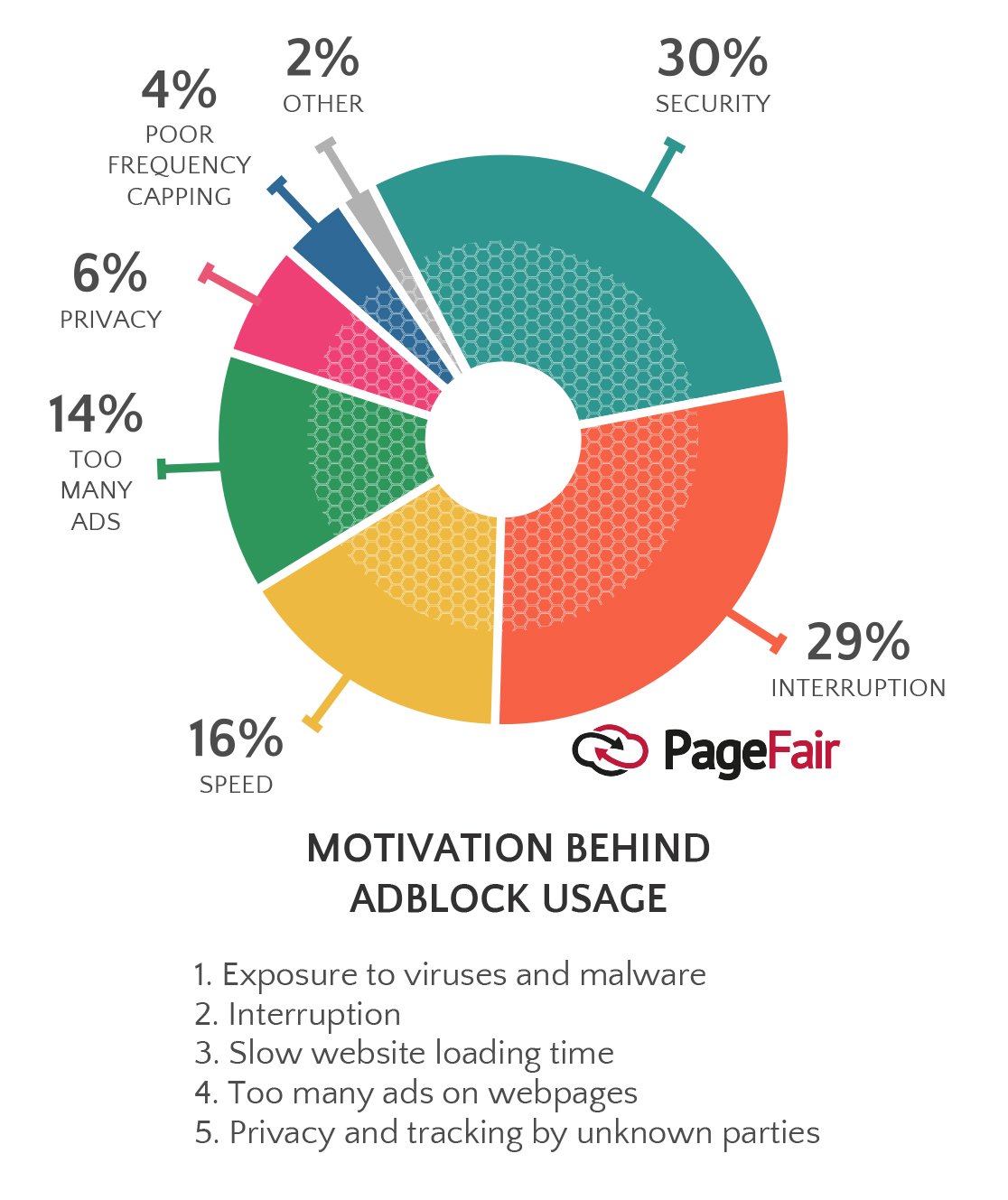
It stands to reason that if you can solve these security and user-experience issues, you can encourage users to switch off ad block — at least on your site.
Looking at the above chart, here are a few steps you can take to resolve audience concerns:
- Security Issues:
Address security concerns by using SSL, auto VPN connect, managing user access, using trust/security badges.
- Interruptive Ads:
Use less intrusive ad formats (say, in-content ads over autoplay videos). Avoid these hated ad formats at all costs.
- Slow Site:
Optimize your site to run faster, such that using ads doesn’t lead to a poor user-experience. Use these 7 tips to start the website optimization process.
- Too many ads:
Keep the number of ads limited on each page. Supplement your ad income by using less interruptive revenue streams (see below).
- Privacy concerns:
Reassure customers that their private data is secure.
While it’s important to respect users’ choices, exploring techniques to circumvent ad blockers within ethical boundaries can be an option.
Some methods include adjusting ad delivery mechanisms, utilizing anti-blocking technologies, or exploring server-side ad insertion. However, it’s crucial to approach these techniques cautiously and consider users’ privacy and experience.
2. Use More Article Ads
Article ads (sponsored content) serve as a viable alternative to standard ads. You’ve undoubtedly seen them across the internet.

Ad block software doesn’t do a particularly good job of removing article ads.
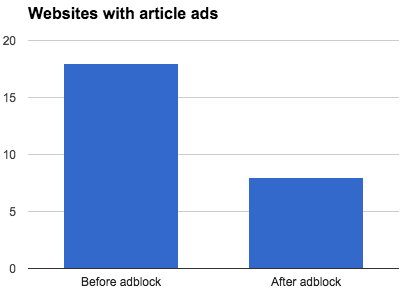
Keep in mind that article ads are not native ads (though many call them as such). Native ads are tailored to your site and require editorial input. Article ads simply use your site as a distribution channel for an advertiser’s existing content.
Thanks to Taboola and Outbrain, this ad format is easy to scale. You also have a lot of flexibility in deciding where and how many of these ad units to use.
The only issue with article ads (besides occasional blocking by ad block) is that the article content might not align with your editorial standards.
Experiment with new ad formats that are less likely to be blocked, such as native video ads, sponsored stories, or interactive ad experiences. Innovating in this space can help you bypass ad blockers while still generating revenue.
3. Create More Native Content
Native ads have long been held as the savior of publishers in the age of ad block. BusinessInsider even admits that native advertising will drive 74% of all publisher revenue by 2021.
As I mentioned earlier, article ads are not native ads (though they are often clubbed together). Native ad content is usually created by the publisher itself and is focused on a topic that aligns with the advertiser’s and the readers’ interests.
Here’s an example from NYT. Note how it feels like a regular article, not an advert:
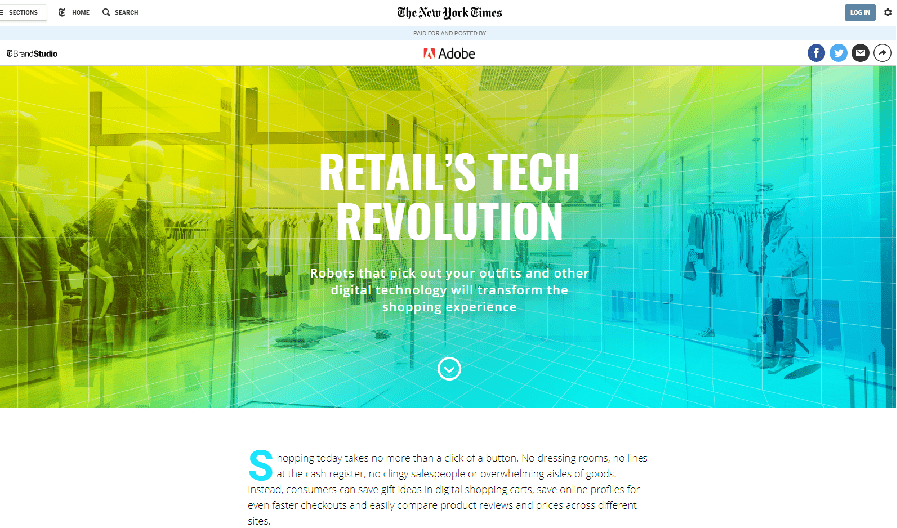
Native advertising can be wildly lucrative, but it also requires more effort to attract and scale. A few challenges you’ll face are:
- Traffic: Since native content is usually unique to a single publisher, you’ll have to have enough traffic to justify the spend for an advertiser.
- Content creation: Suffice to say, native advertising requires you to come up with the content. Which is why so many marquee publishers run their own content studios.
- Reputation: Outside of some start-ups using it as a growth hacking tactic, native content is still dominated by large brands. These brands are usually reluctant to work with publishers without established reputations.
- Sales: Since native content is so decentralized, you’ll have to pound the pavement and get sales yourself. This might make it unfeasible for some publishers.
If you have traffic and/or a highly engaged audience, this is definitely a direction you should explore.
4. Get Whitelisted with Acceptable Ads
Another approach gaining traction is the implementation of “acceptable ads” programs. These programs aim to define criteria for non-intrusive, relevant, and respectful advertising that users might be more inclined to allow.
By adhering to these guidelines, publishers can reach a compromise between ad revenue and users’ preferences, striking a balance that benefits all parties involved.
You can see the full list of whitelisted publishers here. To qualify for this program, your site needs to be:
- High quality
- Serve as few ads as possible
- Ensure that all ads are non-intrusive
AdBlock reviews each application manually and will block your site if you make any large changes post-approval.
It’s tough to get in for most publishers, but if you can, it can offset much of the damage from ad-blocking software.
Else you can simply pay to get in, though expect this to be very expensive since only a few hundred major advertisers have managed it so far (Google, eHow, etc.).
5. Use Blocked Ads to Extract Value
An optimist’s approach to ad blocking is to not see it as lost revenue but as an opportunity to sell products, capture emails and gather data.You know, when life gives you lemons…
You know, when life gives you lemons…
A large number of publishers have adopted this approach. For instance, Forbes detects when a reader is using ad block and asks him to sign-in (i.e. capture data) or whitelist the site:
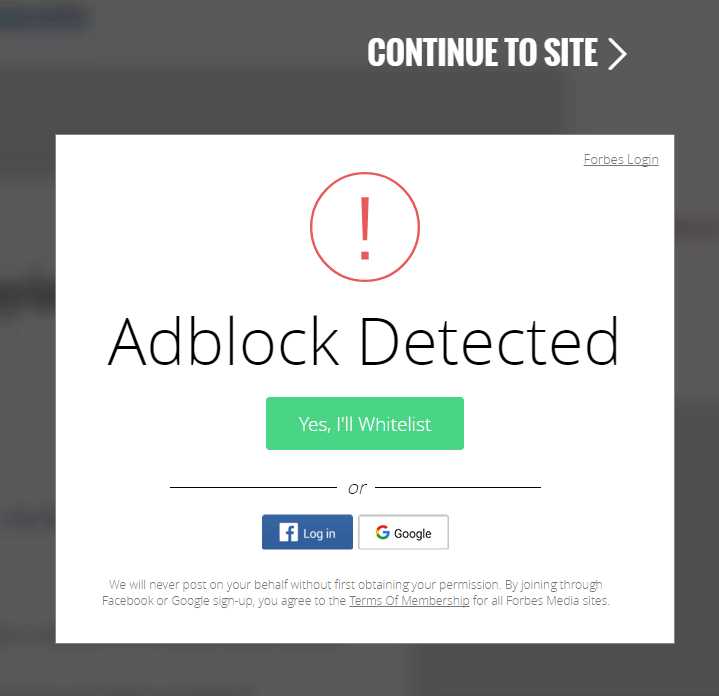
The Atlantic does something similar. You can whitelist the site or even buy a subscription to support Atlantic’s journalism without seeing any ads.
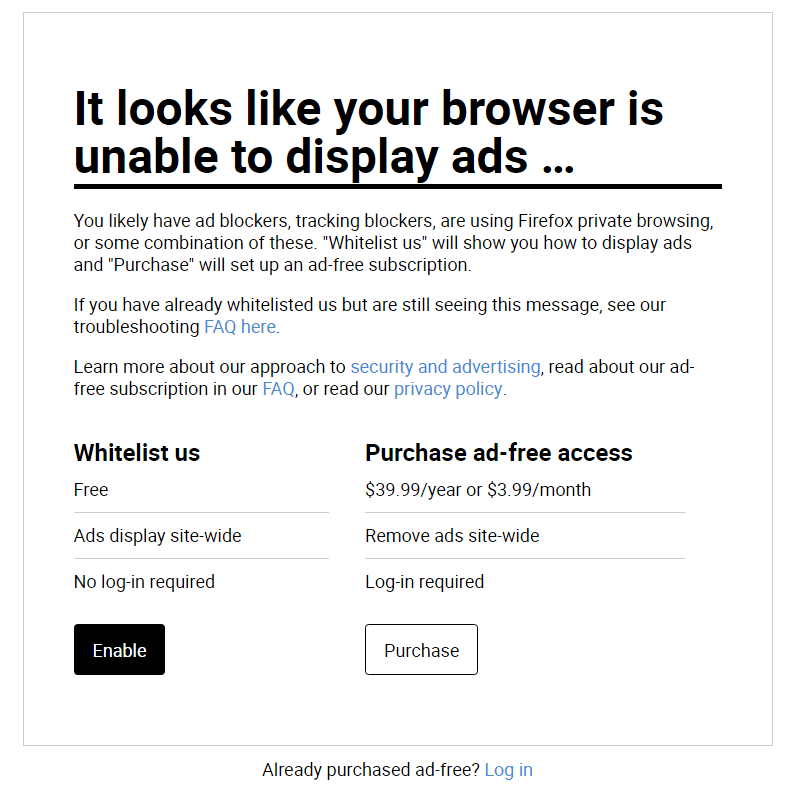
The philosophy behind this approach is clear: if you can’t make any money from ads, at least do whatever you can to extract value from the visitor.
Here are a few things you can do on blocked ad spaces:
- Capture emails by promoting your newsletter. You can later show ads/offers in emails without worrying about being blocked.
- Encourage users to sign-up for a free account (if you have one).
- Encourage users to follow you on social media. This gives you an opportunity to reach users again without being blocked.
- Promote a paid account or product.
6. Start Creating and Promoting Products
This is an approach few publishers are willing to take, but it can be wildly lucrative.
Essentially, this blends media and commerce. Instead of selling ad space to advertisers to push their products, you become your “own advertiser”. That is, you create and sell your own products on your own sites.
A great example of this is Thrillist. What originally started out as an email newsletter turned into a city guide, which turned into a media company. Along the way, Thrillist used its massive audience of millennial men to sell clothing via JackThreads and create one-off products like this hot sauce:

Of course, selling physical products requires a set of skills few publishers have. In that case, you can take the digital route and sell informational products such as eBooks, guides, etc. This is an approach dozens of small blogs and one-man websites use. Examples include Pat Flynn’s eBooks and tools on SmartPassiveIncome or Melyssa Griffin’s courses.
It might not work for publishers in every niche, but if you are in the fitness, education, lifestyle or business niches, it wouldn’t hurt to try.
7. Use Affiliate Marketing
Affiliate marketing is a staple of publishers trying to bolster their revenue without drowning their readers in ads. It works particularly well for established publishers since they usually have strong reader trust and search engine authority (which drives targeted traffic to affiliate pages).
Case in point: the Wirecutter, which was acquired by NYTimes for $30M. Since the Wirecutter does not have ads, all of its $30M in value was derived entirely from affiliate ads.
Relying solely on traditional advertising revenue can be risky in the face of ad blockers. Explore other revenue streams such as sponsored content, native advertising, affiliate marketing, or subscriptions. By diversifying your channels, you can reduce dependency on ad revenue alone.
Engage your audience in meaningful ways that add value to their experience. Offer personalized recommendations, curated content, or exclusive features to entice users and encourage their support.
8. Bypass Adblock
Can you actually bypass ad-blocking software?
A number of startups such as PageFair, SourcePoint, and SecretMedia promise to do exactly that.
For the most part, these tools help you analyze how people use ad block on your site and find ways to circumvent it.
I personally haven’t tested out these services so I can’t comment on their efficacy, but this is another solution you can try.
9. Create a Podcast
Adblock does a great job of removing ads from a page. But it can’t remove audio ads, voiced directly by the speaker in a podcast.
Besides the “podcast revival”, this is one reason why major publishers are investing heavily in podcasting. As things stand, it is an “ad block proof” content format.
NYTimes has The Daily, Popcast, and Still Processing, among others. BBC has The Brexit Cast, Making History, Our Man in the Middle East, etc. Buzzfeed has a whole range of podcasts covering everything from culture to news.

Podcasts can be wildly lucrative as well. For instance, Entrepreneur On Fire’s John Lee Dumas turned his podcast into a $2.5M/year business almost single-handedly.
Even if expanding advertising revenue isn’t one of your priorities, diversifying your content portfolio will help you attract more readers. It’s a win-win for everyone.
Conclusion
Successfully navigating the impact of ad blockers requires a flexible and user-centric approach. By diversifying revenue sources, engaging users effectively, and forming strategic partnerships, businesses can overcome the challenges posed by ad blockers and generate income.
Implementing message-based recovery methods, exploring ethical ad block circumvention techniques, and considering acceptable ad programs offer additional options for mitigating the effects of ad blockers.
It’s important to strike a balance between respecting user choices and finding sustainable ways to maintain revenue streams.
Start monetizing your adblocked ad inventory with AdPushup Ad Block Recovery Solution. Start here.
FAQs
During browsing, ad blockers remove or hide content identified as advertising. Adblockers can take different forms: Independent programs for browsers or operating systems. Browser extensions and plugins.
Ad block traffic poses a challenge because it significantly reduces the potential ad impressions and clicks, which are crucial for generating advertising revenue.
Prioritize user experience by delivering high-quality content, optimizing website performance, and minimizing intrusive elements. Offer personalized recommendations, curated content, or exclusive features that add value to the user experience and encourage users to disable ad blockers voluntarily.
Ad block circumvention techniques should be approached with caution and used within ethical boundaries. It is important to respect users’ choices and privacy while finding ways to deliver ads that provide value without being intrusive or compromising the user experience.
Utilize data analytics to understand user behavior, preferences, and trends. This knowledge can help tailor monetization strategies, deliver targeted and compelling content, and optimize revenue generation efforts.

Shubham is a digital marketer with rich experience working in the advertisement technology industry. He has vast experience in the programmatic industry, driving business strategy and scaling functions including but not limited to growth and marketing, Operations, process optimization, and Sales.

